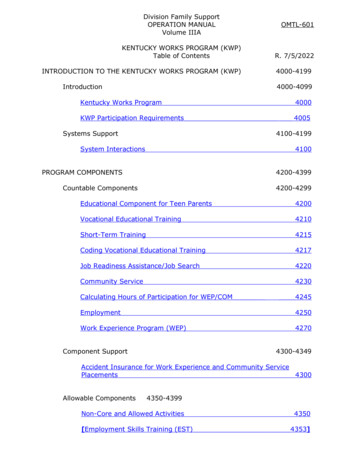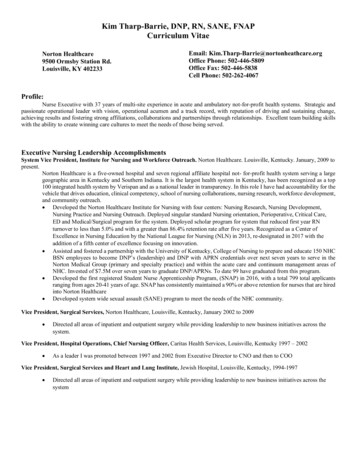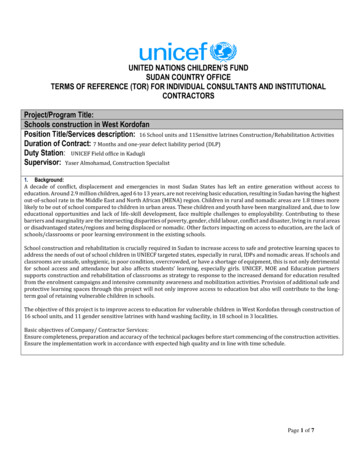
Transcription
Division Family SupportOPERATION MANUALVolume IIIAKENTUCKY WORKS PROGRAM (KWP)Table of ContentsINTRODUCTION TO THE KENTUCKY WORKS PROGRAM (KWP)IntroductionOMTL-601R. 7/5/20224000-41994000-4099Kentucky Works Program4000KWP Participation Requirements 4005Systems Support4100-4199System Interactions4100PROGRAM COMPONENTS4200-4399Countable Components4200-4299Educational Component for Teen Parents4200Vocational Educational Training4210Short-Term Training4215Coding Vocational Educational Training4217Job Readiness Assistance/Job Search4220Community Service4230Calculating Hours of Participation for WEP/COM4245Employment4250Work Experience Program (WEP)4270Component Support4300-4349Accident Insurance for Work Experience and Community ServicePlacements4300Allowable Components4350-4399Non-Core and Allowed Activities4350[Employment Skills Training (EST) 4353]
Domestic Violence Counseling4355Substance Abuse Treatment4365Mental Health Counseling4370Targeted Assessment Program (TAP)4373Vocational Rehabilitation4375Adult Education4380KWP PARTICIPATION4400-5199Case Management4400-4499Staff Roles and ResponsibilitiesAssessment Process44104500-4599General Health Assessment4500Mental Health Assessment4505Learning Needs Assessment4510Addressing Challenges to KWP Participation4515KTAP Transitional Assistance Agreement4520Component Referral and Monitoring Process4600-4699Options for KWP Activities4600Monitoring and Tracking Participation4650KWP Participation Monitoring and Tracking Process4652Verification of Participation4655Excused Absences/Approved Holidays4660Conciliation Due to Noncompliance4700-4749Conciliation Process4700Sanction Exceptions and Good Cause4720Penalty4750-4799Applying the KWP Sanction4750Curing the KWP Sanction In Active KTAP Cases47702
Curing the KWP Sanction at Reapplication4780Resolving Erroneous Sanctions4790UP Participation in KWP4800-5199Unemployed Parent (UP) ParticipationSUPPORTIVE SERVICES48005200-5399Introduction to Supportive ServicesIntroduction to Supportive ServicesChild Care Assistance Program (CCAP)CCAP for KWP ion5300-5349Transportation Authorization and Issuance ProceduresOther Supportive Services53005350-5399Overview of Supportive Services5350Supportive Services Items Subject to 400 Limit5355Fee Payments5365Summer School Tuition Payments5370Car Repairs and Expenses5375Remedial Health Goods/Services5380Authorization and Issuance5385Supportive Services Refunds and Adjustments5388RN and LPN Licensing Authorization53903
Volume IIIAKentucky Works ProgramMS 4000OMTL-507R. 3/1/16KENTUCKY WORKS PROGRAM[The Kentucky Works Program (KWP) assists work eligible individuals to obtainemployment and educational training that lead to self-sufficiency.]A.The goal of KWP is to enable work eligible individuals to meet the primaryobligation to support their children through self-sufficiency, prior to reachingtheir 60-month limit.B.Work eligible individuals are required to participate in KWP unless theindividual meets exemption criteria outlined in Volume III, MS 2324.C.[Participants in KWP may receive supportive services as needed forparticipation. The supportive services include child care (paid through theChild Care Assistance Program), transportation, and other supportiveservices found in MS 5350.]D.A participant with a disability shall receive reasonable accommodation, ifneeded.
Volume IIIAKentucky Works ProgramMS 4005OMTL-601R. 7/5/22KWP PARTICIPATION REQUIREMENTS(1)All work eligible individuals are required to participate in the Kentucky Works Program(KWP) unless the individual meets exemption criteria outlined in Vol. III, MS 2324.It is important to enter and track all KWP activities.The state is required to have a minimum percentage of work eligible individualsparticipate in activities that are defined by federal regulations. Failure to meet therequired rate could result in monetary penalties being imposed on the state.Exempt individuals do not count in or impact the participation rate.A.Activities that count in the federal participation rate are:1.2.Core activities:a.Paid unsubsidized employment (EMP). This does not includeemployment for in-kind income;b.Subsidized employment including the Wage Subsidy Program;c.Work Experience program (WEP);d.Community service programs (COM);e.Job search and job readiness assistance (JRA) for only 6 weeks withno more than 4 consecutive weeks in a 12-month period.Participation in substance abuse treatment programs and mentalhealth counseling may be countable as JRA. See MS 4220;f.Vocational educational training, short-term training that leads to aspecific employment opportunity and a new skill is learned (suchas Certified Nursing Assistant (CNA), accounting, or phlebotomy),or post-secondary education for a maximum of 12 cumulativemonths (VOC);g.Providing child care services for an individual participating incommunity service. See MS 4230; orh.Attendance in secondary school (HSC or GED) for teen parentswho do not have a high school diploma or equivalent.Non-core activities:a.Employment Skills Training (EST) directly related to enhancingemployment skills or developing skills to a new level (such asMicrosoft Office, bank teller takes a course to become a loan officer,or a licensed residential real estate agent becomes licensed forcommercial properties). This is coded as EST and is not includedin the 12 months of VOC;
MS 4005(2)b.Post-secondary activities beyond 12 months if the core requirementis met. This is coded as JSE;c.Education directly related to employment for an individual who hasno high school diploma or equivalent:1)Adult Basic Education or Literacy Instruction. These are codedas ABE;2)General Equivalency Diploma (GED); and3)English as a Second Language (ESL) classes.NOTE: The core hour requirement must be met before non-core hoursbecome countable.B.Activities that are allowed as participation, but do not count whendetermining the federal rates, are:1.Domestic violence counseling (DOM). There are no limits to the lengthof time an individual may participate in this activity;2.Substance abuse treatment programs (SUB). There are no limits to thelength of time an individual may participate in this activity. Programsthat meet the weekly hour requirement can be counted as JRA for up to6 weeks with only 4 weeks consecutive. See MS 4220;3.Mental health counseling (MHA). There are no limits to the length oftime an individual may participate in this activity. Programs that meetthe weekly hour requirement can be counted as JRA for up to 6 weekswith only 4 weeks consecutive;4.Vocational rehabilitation (RHB). There are no limits to the length of timean individual may participate in this activity;5.Literacy (ABE) may count as non-core if the core requirement is metand the individual does not have a high school diploma or GED;6.Adult Education (ABE) may count as non-core if the core requirement ismet and the individual does not have a high school diploma or GED;7.GED Education may count as non-core if the core requirement is metand the individual does not have a high school diploma or GED; and[8. Employment Skills Training (EST) may count as non-core activity if thecore requirement is met or can be considered a non-core allowableactivity. Refer to MS 4353.]Participants should be encouraged to participate in a core activity inconjunction with the above activities when possible.C.The minimum participation rates the State must maintain are:
MS 4005D.(3)1.50% for all families with a work eligible individual; and2.90% for KTAP Unemployed Parent (UP) cases.In order to be countable in the calculation of the federal rates, recipients inKTAP cases are required to participate:1.An average of 30 weekly hours, 20 of which must be in core activities.The remaining hours may be in core or non-core activities;2.An average of 20 weekly hours, all of which must be in core activitiesfor a single custodial parent or single caretaker relative with a childunder 6 years old. If the child’s birthday is the first day of the month,the child is 6 years old. If the child’s birthday is after the first day ofthe month, the child is considered under 6 for that month. The caretakerrelative must be included in the same KTAP EDG as the child under 6years. He/she cannot be the payee of the EDG.Example: Shirley receives KTAP for her child age 12. Shirley has apayee case for her 2 year old nephew. Shirley is required toparticipate 30 hours as the child in her EDG is over 6 yearsold; or3.E.In full-time school attendance, including GED attendance, for a teenparent who is the head of household.In order to be countable in the calculation of the federal rates, work eligiblerecipients in KTAP UP cases are required to participate:1.35 weekly hours, 30 of which must be in core activities. Up to 5 hoursmay be in non-core activities such as adult education, GED or postsecondary activities; or2.55 weekly hours, if the family receives child care assistance (CCAP), 50of which must be in core activities. Up to 5 hours may be in noncoreactivities such as adult education, GED or post-secondary activities.F.On a case-by-case basis, in order to accommodate a disability, the hours andlength of participation and type of activity (core, non-core, or allowed) areadjusted to meet the needs of the participant.G.If an individual receives assistance for only part of a month, that month maybe counted in the federal participation rate if the participant is engaged in anactivity for the minimum average number of hours in each full week theindividual receives assistance in that month.Example: An individual is approved for KTAP benefits on 1/9/08 and isattending college. The individual is required to complete 30 hoursper week to meet the participation requirement. The individualverifies classroom and study hours for the required average of 30hours in each of the weeks beginning 1/9/08. This individual is
MS 4005(4)tracked on OTIS and reported as meeting participation forJanuary.H.An individual may participate in a combination of activities to achieve therequired hours of participation. Only core activities can be used to meet thecore requirement; however, core or noncore activities can be used to meetthe additional required hours of participation.I.Two sets of data are collected for reporting participation rates. The formulafor the federal participation rate is the numerator divided by thedenominator.1.The denominator is the number of cases containing a work eligibleindividual as defined in Vol. III, MS 2322.2.To count in the numerator, a work eligible individual must average thefollowing hours of activity for the given month.a.b.For KTAP cases and the “all family rate”:1)30 weekly hours (20 core hours plus 10 core or noncorehours); or2)20 weekly hours in core activities for a participant who is thesingle custodial parent or single caretaker relative of a childunder 6 years old.3)One parent in a UP case completes 30 hours of core activities.For UP cases, where both members are work eligible, and the “2parent rate”:1)35 weekly hours (30 core hours plus 5 core or noncore hours);or2)55 weekly hours (50 core hours plus 5 core or noncore hours)for participants receiving childcare assistance.If one parent completes 30 hours of the participation requirementfor UP cases, the case counts in the all family rate. This should beencouraged, but it is not mandatory.3.Sanctioned individuals are not counted in the denominator for the firstthree months of sanction within the preceding 12-month period.
Volume IIIAKentucky Works ProgramMS 4100OMTL-577R. 6/1/21SYSTEM INTERACTIONS(1)[Upon approval of KTAP, information from Worker Portal is sent to the OnlineTracking Information System (OTIS) for active work eligible individuals who arenot exempt. There are two exceptions which are not sent: ineligible immigrantsand teen parents not in school. Basic demographic data is passed to OTIS.Changes entered on Worker Portal (e.g., adding a child) that impact the data areupdated on OTIS. However, OTIS does not update Worker Portal, with theexception of the Disqualification Segment for KWP sanction information enteredon the OTIS Sanction Screen.A.Great care must be given to enter the correct KWP status of exempt ornonexempt. If the individual's KWP status changes, update Worker Portalwith the correct information. An incorrect KWP status can delay or denythe issuance of supportive services or Work Incentive (WIN)payments. Additionally, an incorrect KWP status may affect participationrates.B.OTIS is dependent on the information received from Worker Portal, andthe worker cannot enter information or authorize payment on OTIS if theindividual has been identified as exempt.]C.If a KTAP case is to discontinue with earnings and the adult is exempt,remove the exemption prior to adding or increasing the income. This willensure the case is identified for WIN reimbursements, if appropriate.
Volume IIIAKentucky Works ProgramMS 4200EDUCATIONAL COMPONENT FOR TEEN PARENTSOMTL-507R. 3/1/16(1)Attendance in elementary school, middle school, high school, or an equivalentprogram is a core activity for teen parents age 19 and under.A.[If the teen parent under age 18, who is the head of household, hasgraduated from high school or obtained an equivalency diploma, the teenparent is required to participate in a core KWP activity. Failure to participatemay result in a sanction.B.Attendance for teen parents attending high school, middle school, orelementary school is auto tracked from Worker Portal and is verified by aquarterly listing generated to the schools. Teen parents, who are head ofhousehold and age 16, 17, 18, or 19 are auto tracked as long as the schoolattendance information is entered correctly and verified on Worker Portal.C.If you discover that school attendance questions were not answeredappropriately on Worker Portal for a teen parent who is head of household,age 19 or under and is attending high school; a HSC component should beentered on OTIS and tracked for any months for which participation can stillbe captured. See MS 4650.D.For teen parents who are head of household, attending GED or otherequivalent program, participation is entered and tracked on OTIS by entryof the appropriate component code: General Educational Development(GED), Adult Basic Education or Literacy Instruction (ABE).]
Volume IIIAKentucky Works ProgramMS 4210OMTL-507R. 3/1/16VOCATIONAL EDUCATIONAL TRAINING(1)Vocational educational training is an organized educational program directly relatedto preparing individuals for employment including baccalaureate and advanceddegree programs. Full-time or part-time attendance in this activity can be used tomeet core federal participation requirements for a maximum of 12 cumulativemonths. OTIS will track the number of months used to meet the core requirement.If vocational educational training hours are less than the individual’s KWPrequirement, the hours can be combined with another core component in order tomeet participation.Federal guidelines allow individuals enrolled in online courses to receive the samecredit for participation as those who attend conventional courses, providing the actualhours spent online are monitored and recorded by the educational institution.A.Vocational educational training includes the following:1.Classroom training in one and two year programs at a state technicalcollege, area vocational education center or Job Corps;2.Programs including advanced degrees, such as masters, PhD, orlicensed certified practitioner, at two and four year colleges when theparticipant has a specific occupational goal;3.Customized training offered on a short-term basis at a state vocationaltechnical school or other provider. For additional information, refer toMS 4215; and4.A proprietary school program with a specific occupational goal.Basic skills training or English as a Second Language (ESL) may count asvocational educational training when it is part of the vocational educationaltraining.B.In order to correctly count hours that meet participation criteria:1.Use actual CLASSROOM hours, not credit hours, as the weekly scheduledhours on OTIS. For example, physical education classes are often 1credit hour, but classes meet 3 hours per week. When possible, reviewclass schedules to determine the actual classroom hours.2.Scheduled activities outside classroom hours which count toward KWPparticipation include:a.Clinicals for medical courses;b.Cooperative (co-op) program hours;c.Internships;d.Labs;
MS 4210(2)3.e.Tutoring;f.Study time in a supervised setting; andg.[One hour of unsupervised study time for each hour of class timewhich can include online classes that are verified by the provider.Work study programs are considered countable hours of employmentand the hours are entered on Worker Portal. See MS 4250 for theappropriate system entry of work study income.]C.Vocational educational components, when used to meet the 20-hour corerequirement for a maximum of 12 cumulative months, are coded on OTISas VOC.D.Vocational educational components are coded JSE on OTIS when not usedto meet the 20-hour core requirement, such as when the participant meetsthe core requirement through work study or another core component.See MS 4217 for additional information relating to the coding of vocationaleducation components.E.The time between semesters or weeks where there is no participation musteither be made up or the individual must be placed in another countableactivity.
Volume IIIAKentucky Works ProgramMS 4215OMTL-601R. 7/5/22SHORT-TERM TRAINING(1)Short-term training is customized training offered in a short time period that leads toa specific employment opportunity.A.Short-term training programs should be made available to qualifiedparticipants. All referrals for short-term training must have prior approval.Case managers make payments for short-term training programs.1.Each Regional Office will designate staff responsible for determining if anew training class meets KWP criteria. Contact the designated staff inyour region before referring individuals to a new short-term trainingclass.If the information is questionable, please send the classcurriculum for review to the Family Self-Sufficiency Branch (FSSB) atFSSBK-TAP@ky.gov.2.Eligibility criteria for a short-term training class include:a.Training that is not covered by federal financial aid. For example,courses less than 50 clock hours at a technical college, nurse aidetraining, and classroom training for Child Development Associates(CDA);b.Training that is in accordance with the participant's job goal andlocal labor market trends. The opportunity for a job using the shortterm training must exist when training is complete; andc.[Training class fees should not exceed 1,000 per class perindividual.If a short-term training class fee exceeds 1,000 and it isdetermined the short-term training is appropriate in movingthe individual to employment, the KWP Program Specialist ordesignated individual contacts FSSB for approval.]3.The case manager refers the individual to the short-term trainingprogram after the approval of the KWP specialist or supervisor.4.Trainings are limited to 2 per person per 12-month period regardless ofthe cost of each short-term training class.5.Obtain the provider's complete name and mailing address to completeform KW-215, Short-Term Training Referral Form.6.After the short-term training class is approved:a.Explain to the training facility that form KW-215, must be completedand returned.b. Payment is authorized when form KW-215 is returned completed bythe provider. If the form needs to go to a specific person, enter that
MS 4215(2)information in the address line 2. For example, if XYZ School wantsthe check to be routed to Mary Smith, enter:XYZ SchoolAttn: Mary Smith104 School RoadAnytown, Ky 40000c.7.Explain the requirement to monitor and track attendance with thecompletion process for form KW-33, Verification of Kentucky WorksProgram Participation or other participation verification.The case manager:a.Refers participants to attend training.b.Creates form KW-215 from the Supportive Services screen on OTISand gives the form to the KWP participant. The participant takesthe form to the provider for completion and return. If the trainingis paid by Big Sandy ADD, then form KW-215 is issued through theIntranet forms library and is for referral purposes only.c.Upon receipt of the completed form KW-215, issues the payment onOTIS and scans the form into the category KWP in the ElectronicCase File (ECF).8.Short-term training is considered vocational training and counts in the12 cumulative months allowed to be counted in the federal participationrate.9.Enter all short-term training classes on OTIS as the component typeVOC. If the provider is not listed in the dropdown menu as a VOCprovider, choose generic as the VOC provider and enter provider detailsinformation from form KW-215.10. Tracking must be completed for short-term training. OTIS will track themonths of the VOC component toward the countable 12 months ofvocational educational training.B.For all counties served by the Big Sandy ADD, Big Sandy ADD staff will paythe following:1.All short-term training tuition costs.2.All fees related to short-term training. This does not include non-feeitems, such as uniforms, that DCBS pays as a supportive service.
Volume IIIAKentucky Works ProgramMS 4217CODING VOCATIONAL EDUCATIONAL TRAININGOMTL-549R. 9/1/19(1)Participation in vocational education activities as a core activity (VOC) is limited toa maximum of 12 months. The individual must meet the required number of hoursto count in the federal participation rate. OTIS tracks the number of months VOCis used to meet the core requirement and total months can be found on the OTISGeneral Information screen. For this reason it is very important that coding ofvocational education on OTIS be completed as follows:A.B.Attendance in a vocational educational training can be used to meet thefederal participation requirements for a maximum of 12 cumulative months.1.Participants are placed in VOC components during their 12 cumulativemonths.2.Any month the vocational activity component (VOC) is used to meet thecore requirement OTIS counts as one of the 12 cumulative monthsreported in the federal rate, regardless of whether participation wasmet.If an individual has completed 12 cumulative months of vocationaleducational training, or he/she wishes to preserve VOC months, he/she mayparticipate in post-secondary activities if the core requirement is met byparticipation in other core activities. These individuals are placed in JSE, anon-core component.1.Close the VOC component on OTIS.2.Use the JSE component to indicate continued participation in thevocational educational activity.3.The JSE component is used when hours are combined with a coreactivity to meet the participation requirement. See MS 4210, Item D.a.JSE activity must be tracked on OTIS in order to count in theparticipation rate.b.[Hours in JSE will only count for individuals who are required toparticipate 30 hours per week and need core or non-core hours inaddition to 20 core hours in COM, WEP, employment or work study.JSE cannot be used for individuals required to participate only 20core hours.c.For unemployed parent (UP) cases, JSE is used for the 5 hoursrequired in addition to the 30 or 50 core hours in a COM, WEP,employment or work study.]To meet the 35/55 hour work requirement, a parent in a UP casemay participate in vocational educational training for the 12cumulative months; however, both parents in a UP case cannot
MS 4217(2)participate in a vocational educational training component at thesame time unless one parent is meeting the required number of corehours (30/50).Example: A UP household is required to participate 35 hours perweek and one parent is meeting the required 30 hours inVOC with actual class hours and unsupervised andsupervised study time. The other parent can completethe remainder of the requirement in another core or noncore activity, such as employment, community service,JSE, etc.C.Individuals remain in the JSE component if he/she continues to attendvocational training but the hours are not needed to count towards theparticipation rate. These hours are only collected for reporting purposes.D.For an individual who meets the core participation requirement of 20 hoursper week through employment, work study, or WEP/COM and also ngtoJSEin OTIS. The vocational training in this type of situation is not consideredpart of the 12 months.E.Activities which involve paid employment, including work study, are shownas paid employment on Worker Portal. However, work study income isexcluded income in the KTAP case.G.Internships, practicum, clinical, and co-op programs which do NOT involvepaid employment may be considered as hours toward the vocationaleducational training or may be a WEP or COM placement. Hours in WEP orCOM cannot exceed either the FLSA calculation or the weekly participationrequirement, whichever is less. For example, if the clinical requires 20 hoursa week and the calculation only allows 6 hours per week, we track 6 hours inthe WEP/COM. For more information see MS 4230 for COM and MS 4270 forWEP.1.The Ready to Work Coordinator at the educational institution will workwith the Family Support KWP staff to identify potential WEP or COMplacements which may include:a.Internships which involve no pay;b.Practicum which involve no pay, including student teaching;c.Co-ops which involve no pay;d.On-campus volunteer activities; ore.Off-campus volunteer activities.2.The Ready to Work Coordinator will assist with the monitoring andreporting on these activities.3.The Ready to Work Coordinator will also monitor supervised study time.
Volume IIIAKentucky Works ProgramMS 4220OMTL-581R. 9/1/21JOB READINESS ASSISTANCE/JOB SEARCH(1)Job Readiness Assistance (JRA) is preparation to seek and obtain employment. Theseservices are provided by various contractors located throughout the state. Servicesinclude development of job seeking skills as well as activities designed to removebarriers to employment such as substance abuse treatment, mental healthtreatment, rehabilitative services, and life skills training.Job Search, coded as JRA, is the active search for employment that must includecontact with potential employers.Participation in either JRA or Job Search or a combination of both may be countableas a CORE activity in the federal participation rate for a maximum of six weeks in apreceding 12-month period. A break of one week or more must occur after fourconsecutive weeks of participation in JRA or Job Search before the remaining twoweeks are countable in the federal rate.If the participant requires these services for a longer period of time within the same12-month period, the activity may be allowed but will not count in the federal rates.The component code on OTIS can be MHA, RHB, SUB, or DOM, depending on theactivity of the participant.Contractors can report relevant information regarding a participant on OTIS.A.Contractors responsible for providing JRA job seeking skills provide:1.Classes that start the first work day of a month that allows for 4 fullweeks of participation;If contractors offer two week JRA classes, individuals can participate twoweeks of JRA classes and four weeks of Job Search, with at least oneweek break in between.2.Training in communication, conflict resolution, interviewing techniques,resume preparation, budgeting, and other relevant topics;3.Employment counseling;4.Other services which may be identified regionally.B.Substance abuse treatment, mental health treatment, or rehabilitative servicescan be countable as JRA activities. This treatment must be determinednecessary by a qualified medical or mental health professional and are servicesscheduled on a regular basis that occur no less than the 20/30 hour per weekrequirement.C.[Job Search (JRA) may be directed by either a contractor or the case manager.The participant reported hours are used for tracking the Job Search activity.Travel time between interviews can be counted, but not time to and from theparticipant’s home. Verification requirements for Job Search include:]
MS 4220(2)1.A daily log of employer contacts (in person, internet, or phone)maintained by the participant that includes the date and time of eachcontact, length of contact, type of contact, employer name and contactinformation, and desired position.Form KW-300, KWP Job Search Documentation, is an optional form forKWP participants to log information on job search activity, such as typeof contact, date and time of contact, employer’s name, address andcontact number, and the result of contact.2.Submission of the participant log or form KW-300 to the contractor orcase manager is completed monthly, for review, approval, and retentionin the case record.If the participant log or form KW-300 is incomplete or questionable,contact is made with the employer.
Volume IIIAKentucky Works ProgramMS 4230OMTL-557R. 12/1/19COMMUNITY SERVICE(1)Community service is a structured program where participants perform work for thedirect benefit of the community under the sponsorship of a nonprofit organization.The projects are limited to those that serve a useful community purpose. Examplesof permitted community service placements include churches, the Red Cross, BigBrothers/Big Sisters, Habitat for Humanity, local government, and public schools.Providing child care for another KWP individual who is participating in a communityservice activity is also permitted as a community service placement.A.Community service placements can be identified by the case manager or theparticipant. Placements are usually positions staffed by volunteers in anorganization. The organization must be a non-profit or public agency.B
Vocational Educational Training 4210 Short-Term Training 4215 Coding Vocational Educational Training 4217 Job Readiness Assistance/Job Search 4220 Community Service 4230 Calculating Hours of Participation for WEP/COM_ _4245 Employment 4250 Work Experience Program (WEP) 4270 Component Support 4300-4349










